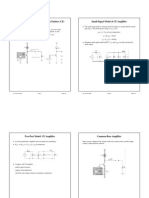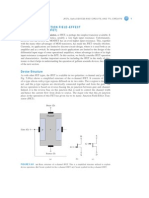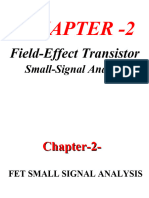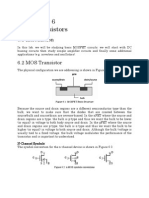0 ratings0% found this document useful (0 votes)
32 viewsLecture 21: Junction Field Effect Transistors. Source Follower Amplifier
Lecture 21: Junction Field Effect Transistors. Source Follower Amplifier
Uploaded by
casprossit contains all the important information about capacitors
Copyright:
Attribution Non-Commercial (BY-NC)
Available Formats
Download as PDF, TXT or read online from Scribd
Lecture 21: Junction Field Effect Transistors. Source Follower Amplifier
Lecture 21: Junction Field Effect Transistors. Source Follower Amplifier
Uploaded by
caspross0 ratings0% found this document useful (0 votes)
32 views8 pagesit contains all the important information about capacitors
Original Title
capasitors
Copyright
© Attribution Non-Commercial (BY-NC)
Available Formats
PDF, TXT or read online from Scribd
Share this document
Did you find this document useful?
Is this content inappropriate?
it contains all the important information about capacitors
Copyright:
Attribution Non-Commercial (BY-NC)
Available Formats
Download as PDF, TXT or read online from Scribd
Download as pdf or txt
0 ratings0% found this document useful (0 votes)
32 views8 pagesLecture 21: Junction Field Effect Transistors. Source Follower Amplifier
Lecture 21: Junction Field Effect Transistors. Source Follower Amplifier
Uploaded by
casprossit contains all the important information about capacitors
Copyright:
Attribution Non-Commercial (BY-NC)
Available Formats
Download as PDF, TXT or read online from Scribd
Download as pdf or txt
You are on page 1of 8
Whites, EE 322 Lecture 21 Page 1 of 8
2006 Keith W. Whites
Lecture 21: Junction Field Effect
Transistors. Source Follower Amplifier
As mentioned in Lecture 16, there are two major families of
transistors. Weve worked with BJ Ts in the past few lectures.
The second transistor type we will consider is the field effect
transistor (FET). In the NorCal 40A, we use discrete junction
field effect transistors (J FETs). (Recall that in ICs, metal oxide
semiconductor FETs are usually used.)
Four important points concerning the J FET are:
1. Probably the simplest transistor,
2. Very large input impedance (but MOSFETs even larger),
3. Virtually obsolete compared to the MOSFET,
4. Now used mainly in discrete circuit design switches,
amplifiers, etc.
In the NorCal 40A, J FETs are used in the:
1. Buffer Amplifier (as a buffer amplifierduh!),
2. Variable Frequency Oscillator, VFO (as the gain element in
the oscillator),
3. Automatic Gain Control, AGC (as a voltage controlled
variable resistance).
Whites, EE 322 Lecture 21 Page 2 of 8
Physical Behavior of Junction Field Effect Transistors
As with BJ Ts, there are n and p type J FETs. We use only n-type
in the Norcal 40A (the J 309).
p
n
n
p
Drain
Gate
Source
-
-
-
-
-
-
Channel
D
e
p
l
e
t
i
o
n
R
e
g
i
o
n
+
-
d (Drain)
s (Source)
g (Gate)
v
gs
I
d
D
e
p
l
e
t
i
o
n
R
e
g
i
o
n
Notice that the gate is reversed biased wrt the source, which is
itself often connected to the p-type body.
By making V
gs
more negative, the gate pn junction develops a
larger depletion region. This has the effect of narrowing the
channel and, consequently, decreasing I
d
(the drain current).
Eventually, when
( )
0
gs c
V V = <
the channel becomes closed (or pinched off). V
c
is called the
cutoff voltage and is less than zero. (For the J 309, 2.5
c
V V.)
Mathematically, the drain current is expressed as
Whites, EE 322 Lecture 21 Page 3 of 8
2
1
gs
d dss
c
V
I I
V
=
[A] (9.74)
I
dss
is the drain to source current with the gated shorted to the
source. This characteristic curve is shown in Fig. 9.15:
V
c
I
dss
I
d
V
gs
2
1
gs
d dss
c
V
I I
V
=
0
Foward biased gate
diode: not operational.
Channel cutoff Channel is maximum
The slope of this drain current versus V
gs
is called the
transconductance g
m
of the J FET:
d
m
gs
dI
g
dV
= [S] (9.75)
The significance of g
m
to a J FET is analogous to for a BJ T.
Substituting (9.74) into (9.75) and performing the differentiation
gives
2 1
gs
dss
m
c c
V
I
g
V V
=
[S] (9.76)
This curve is simply a straight line, as shown in Fig 9.16:
Whites, EE 322 Lecture 21 Page 4 of 8
V
c
g
m
V
gs
2 1
gs
dss
m
c c
V
I
g
V V
=
0
2
dss
c
I
V
Interestingly, we see that g
m
actually changes as V
gs
changes.
The for BJ Ts did not have such dependence. Later in Section
11.4 (and Probs. 26 and 27), we will harness this behavior of
J FETs to make a nice oscillator!
Small Signal Model of the JFET
The low frequency, small signal model for an n-type J FET is
shown in Fig. 9.17a:
r
o
g
m
v
gs
d
g
s
+
-
v
gs
The gate is open circuited, which models the extremely large
input impedance of properly biased J FETs (remember that the
Whites, EE 322 Lecture 21 Page 5 of 8
input can be a reversed-biased pn junction). This input
impedance is easily greater than 1 M.
In the model above, r
o
is the output resistance of the J FET. Its
often neglected in paper analysis of these circuits. (However, in
Prob. 27, 5
d o
r r = = k is used in second-order calculations.)
Source Follower FET Amplifier
A J FET source follower amplifier is very similar to the BJ T
emitter follower (Fig. 9.17b):
+
-
v
i
V
dd
R
+
-
v
The FET source follower (1) has a very large input impedance,
(2) is very simple to bias, and (3) has 1
v
G .
The source follower is used in the Buffer Amplifier (Q5) in the
NorCal 40A. The Buffer Amplifier isolates the Transmit Mixer
from the Driver Amplifier. This isolation keeps changes in the
input impedance to the Driver Amplifier from affecting the
Transmit Mixer.
Whites, EE 322 Lecture 21 Page 6 of 8
Surprisingly, R alone is all thats needed to set the bias of the
source follower, provided the gate is dc grounded (but, of
course, not ac grounded!).
As an example of a dc grounded gate, consider the Buffer
Amplifier in the NorCal 40A. Notice that R10 and L6 provide a
dc path to ground so there is no dc current. Also, notice that ac
signals at the gate are not grounded.
The dc source voltage in the above circuit is
s b
V I R =
where I
b
is the drain to source bias current. Then,
0
gs g s b b
V V V I R I R = = = (9.77)
This is simply an equation for a straight line. This straight line is
the load line and we can use it together with the J FET
characteristic equation (9.74) to determine the dc bias point for
V
gs
and I
ds
.
Referring to Fig. 9.18:
V
c
I
dss
I
d
V
gs
2
1
gs
d dss
c
V
I I
V
=
0
1
R
Load line
V
b
I
b
dc bias pt
Whites, EE 322 Lecture 21 Page 7 of 8
The intersection of the load line with the J FET characteristic
curve gives a graphical solution for the dc bias point of the
source follower amplifier: V
gs
=V
b
and I
d
=I
b
.
Once the source follower has been properly biased, the ac output
impedance and the voltage gain can be easily determined. Using
the small-signal equivalent circuit model for the source follower
(Fig. 9.17c):
R
g
m
v
gs
d
g
s
+ - v
gs
+
-
v
i
+
-
v
From this circuit we see that
m gs
v g v R = (9.78)
where
gs g s i
v v v v v = = (9.79)
Substituting (9.79) into (9.78) we find
( )
m i m i m
v g R v v g Rv g Rv = =
or
( )
1
m m i
g R v g Rv + =
Now, solving for the ratio of output to input voltage, we find
1
m
v
i m
v g R
G
v g R
=
+
Whites, EE 322 Lecture 21 Page 8 of 8
or
1
1
1
m
v
g R
G =
+
(9.82)
where G
v
is the voltage gain.
The J FET transconductance is usually quite small. But if we
choose R such that 1
m
g R (i.e.,
1
m
R g
), then
1
v
G
which is typical for a source-follower J FET amplifier.
You might also like
- Triode Emulator by Dimitri DanyukDocument8 pagesTriode Emulator by Dimitri Danyukt_ca100% (2)
- JBL Flip 6Document30 pagesJBL Flip 6maibac3300No ratings yet
- Solutions Manual Digital Logic Circuit Analysis DesignDocument58 pagesSolutions Manual Digital Logic Circuit Analysis DesignHoàng LongNo ratings yet
- Biodata Sonification - Arduino Shield Breadboard Kit v02Document59 pagesBiodata Sonification - Arduino Shield Breadboard Kit v02RJ BevyNo ratings yet
- Chapter 9Document13 pagesChapter 9Huy HoNo ratings yet
- BEE Small Signl ModelDocument13 pagesBEE Small Signl ModelalysonmicheaalaNo ratings yet
- FETDocument49 pagesFETPalak Agrawal100% (2)
- L #5: Mosfet C A: Sfsu - E 301 - E L AB Haracteristics and PplicationsDocument14 pagesL #5: Mosfet C A: Sfsu - E 301 - E L AB Haracteristics and PplicationsRudra MishraNo ratings yet
- Sedra SmithDocument52 pagesSedra SmithJiveshNo ratings yet
- Lsk489 Guide to Fets for Voltage Controlled CircuitsDocument10 pagesLsk489 Guide to Fets for Voltage Controlled Circuitsanalogio codeNo ratings yet
- 2.9 Junction Field-Effect TransistorsDocument9 pages2.9 Junction Field-Effect TransistorsSrinivas KrishnaNo ratings yet
- Unit Vii Fet AmplifiersDocument14 pagesUnit Vii Fet AmplifiersAadarsha timilsina100% (1)
- Chapter 2Document24 pagesChapter 2ahmdnmr213No ratings yet
- Mosfet Lab 2Document11 pagesMosfet Lab 2Jaime Aguilar100% (1)
- Bilotti 1966Document3 pagesBilotti 1966dycsteiznNo ratings yet
- The Jfet: Device EquationsDocument9 pagesThe Jfet: Device EquationsRC_RamCharanNo ratings yet
- Eec 234 Electronics 2 PracticalDocument39 pagesEec 234 Electronics 2 Practicalblessingmonday2199No ratings yet
- Chapter 10 Field Effect TransistorsDocument48 pagesChapter 10 Field Effect TransistorsanjugaduNo ratings yet
- FETDocument91 pagesFETpawan_32No ratings yet
- Small Signal Model in BJT and MOSFETDocument8 pagesSmall Signal Model in BJT and MOSFETGeorge BurdellNo ratings yet
- Chapter 4 - JFET PDFDocument13 pagesChapter 4 - JFET PDFnelsonjnelsonjNo ratings yet
- Regulation - 2018: Basic Electronics-18ELN14Document12 pagesRegulation - 2018: Basic Electronics-18ELN14DaisyQueenNo ratings yet
- The Basic Structure: Field Effect TransistorDocument10 pagesThe Basic Structure: Field Effect TransistormokhaladNo ratings yet
- Mosfet Small SignalDocument7 pagesMosfet Small SignalTabraizShahNo ratings yet
- Discussion JfetDocument3 pagesDiscussion JfetAldwin AlquitranNo ratings yet
- BJTs Small SignalsDocument17 pagesBJTs Small SignalsBokang MaphatheNo ratings yet
- FET Basics 1Document63 pagesFET Basics 1Juno Hera Magallanes HuyanNo ratings yet
- Department of Electronics & Telecom Engineering EDC-1 Question Bank For IA-02 A.Y 2021-22Document7 pagesDepartment of Electronics & Telecom Engineering EDC-1 Question Bank For IA-02 A.Y 2021-22Pratik BhalakeNo ratings yet
- JFETs and MOSFETSDocument17 pagesJFETs and MOSFETSBokang MaphatheNo ratings yet
- Two-Port Parameters For Single-Stage Amplifiers: R R G R RDocument8 pagesTwo-Port Parameters For Single-Stage Amplifiers: R R G R RduefeNo ratings yet
- Microdevices: Mosfets - Metal Oxide Field Effect Transistors N MosfetDocument11 pagesMicrodevices: Mosfets - Metal Oxide Field Effect Transistors N Mosfetblue7nicoNo ratings yet
- FET Basics 1Document47 pagesFET Basics 1padmavathy2k0% (1)
- RCA MOS FET Biasing 1970Document8 pagesRCA MOS FET Biasing 1970ulisses.farinaNo ratings yet
- Unit VDocument23 pagesUnit Vammireddybhavya2006No ratings yet
- Lecture 8Document14 pagesLecture 8Altaher Bushra AdamNo ratings yet
- Final MosfetDocument33 pagesFinal MosfetabdallaNo ratings yet
- 1 - ACKTS - Unit 1 Learning MaterialDocument39 pages1 - ACKTS - Unit 1 Learning Materialtemp29890No ratings yet
- Unit 5 - Electronic Devices - WWW - Rgpvnotes.inDocument17 pagesUnit 5 - Electronic Devices - WWW - Rgpvnotes.inprakharNo ratings yet
- Lecture 34: MOSFET Common Gate AmplifierDocument9 pagesLecture 34: MOSFET Common Gate AmplifierLoiLeVanNo ratings yet
- Bipolar Junction Transistor (BJT) Junction Field Effect Transistor (JFET)Document5 pagesBipolar Junction Transistor (BJT) Junction Field Effect Transistor (JFET)sgmdhussainNo ratings yet
- FET AmplifiersDocument67 pagesFET Amplifierssevenscarlet134No ratings yet
- Curve Tracer PDFDocument8 pagesCurve Tracer PDFurenhu9970100% (2)
- Field Effect Transistors (Fets) : - Two Types of FetDocument28 pagesField Effect Transistors (Fets) : - Two Types of FetCruise_IceNo ratings yet
- ENEE307 Lab6 FinalDocument11 pagesENEE307 Lab6 FinalThing0256No ratings yet
- V DR - RR&DR - SR Techincal University Lab Manual: EltechDocument25 pagesV DR - RR&DR - SR Techincal University Lab Manual: EltechadiprasanthNo ratings yet
- The Jfet: Device EquationsDocument9 pagesThe Jfet: Device EquationsQuoc Khanh PhamNo ratings yet
- Class AB Push-Pull Vacuum Tube Guitar Amplifier Analysis, Design, and ConstructionDocument14 pagesClass AB Push-Pull Vacuum Tube Guitar Amplifier Analysis, Design, and ConstructiontekellamerZ aka tekellamer100% (2)
- Junction Field Effect Transistor (JFET) : Gate Terminal. The Other Two Contacts, The Drain and Source, Are Placed atDocument8 pagesJunction Field Effect Transistor (JFET) : Gate Terminal. The Other Two Contacts, The Drain and Source, Are Placed atkingboyNo ratings yet
- Design of 22-32 To 15 V Buck ConverterDocument7 pagesDesign of 22-32 To 15 V Buck ConverterAnuar Alfredo Gonzalez SolarNo ratings yet
- 6 Log Anti Log AmplifiersDocument32 pages6 Log Anti Log AmplifiersAnonymous eWMnRr70q0% (1)
- Small Signal Model MOSFETDocument8 pagesSmall Signal Model MOSFETRAHUL100% (1)
- BEng FETDocument13 pagesBEng FETJai GaizinNo ratings yet
- Vishay Siliconix: Switching Ground-Return LoadsDocument4 pagesVishay Siliconix: Switching Ground-Return LoadsJorge GuerreroNo ratings yet
- Electronic Circuits - 1 Unit - 3 Small Signal Analysis of JFET and MOSFET Amplifiers Biasing of Fet Amplifiers Fixed BiasDocument17 pagesElectronic Circuits - 1 Unit - 3 Small Signal Analysis of JFET and MOSFET Amplifiers Biasing of Fet Amplifiers Fixed BiasMutharasu SNo ratings yet
- Part V FETDocument68 pagesPart V FEThstrybestNo ratings yet
- Circuit Building BlocksDocument16 pagesCircuit Building Blockslid20No ratings yet
- Easy(er) Electrical Principles for General Class Ham License (2019-2023)From EverandEasy(er) Electrical Principles for General Class Ham License (2019-2023)No ratings yet
- Easy(er) Electrical Principles for General Class Ham License (2015-2019)From EverandEasy(er) Electrical Principles for General Class Ham License (2015-2019)Rating: 5 out of 5 stars5/5 (1)
- Reference Guide To Useful Electronic Circuits And Circuit Design Techniques - Part 2From EverandReference Guide To Useful Electronic Circuits And Circuit Design Techniques - Part 2No ratings yet
- Reference Guide To Useful Electronic Circuits And Circuit Design Techniques - Part 1From EverandReference Guide To Useful Electronic Circuits And Circuit Design Techniques - Part 1Rating: 2.5 out of 5 stars2.5/5 (3)
- Fundamentals of Electronics 1: Electronic Components and Elementary FunctionsFrom EverandFundamentals of Electronics 1: Electronic Components and Elementary FunctionsNo ratings yet
- Tunnel Field-effect Transistors (TFET): Modelling and SimulationFrom EverandTunnel Field-effect Transistors (TFET): Modelling and SimulationNo ratings yet
- Derivation of LapceDocument6 pagesDerivation of LapcecasprossNo ratings yet
- Comprehensive Basic Mathematics Vol 2Document576 pagesComprehensive Basic Mathematics Vol 2caspross100% (2)
- +1 Chemistry: Super Scorer Super Scorer Super Scorer Super Scorer Super ScorerDocument4 pages+1 Chemistry: Super Scorer Super Scorer Super Scorer Super Scorer Super ScorercasprossNo ratings yet
- Cosmology: The Expanding UniverseDocument17 pagesCosmology: The Expanding UniversecasprossNo ratings yet
- Softwares-Application SoftwareDocument9 pagesSoftwares-Application SoftwarecasprossNo ratings yet
- Jagran JoshDocument115 pagesJagran JoshAnkit AroraNo ratings yet
- Model Exam: 1. Draw Figures Neatly For Each Question If Applicable. 2. Answer All Questions CompulsaryDocument2 pagesModel Exam: 1. Draw Figures Neatly For Each Question If Applicable. 2. Answer All Questions CompulsarycasprossNo ratings yet
- QmechDocument222 pagesQmechFaktor123456No ratings yet
- Banking TermsDocument3 pagesBanking TermscasprossNo ratings yet
- Indian History FullDocument178 pagesIndian History FullabusajuNo ratings yet
- Department of Political Science: Sheet1Document1 pageDepartment of Political Science: Sheet1casprossNo ratings yet
- Ruiyan - Ry-P100-Pon MeterDocument2 pagesRuiyan - Ry-P100-Pon Metersergio sabNo ratings yet
- Installation of Embedded Galvanic Anodes: Field Guide To Concrete Repair Application ProceduresDocument7 pagesInstallation of Embedded Galvanic Anodes: Field Guide To Concrete Repair Application ProceduresماقوريNo ratings yet
- Praveen Rajeev: Service EngineerDocument3 pagesPraveen Rajeev: Service EngineerNagarajNo ratings yet
- 146-Vt CVT ManualDocument14 pages146-Vt CVT ManualjdsfklsdjfsfdjlfjlnNo ratings yet
- Automatic Dielectric Breakdown TesterDocument4 pagesAutomatic Dielectric Breakdown TesterSyamberah SyamberahNo ratings yet
- Statement of Purpose For PHD in Purdue UniversityDocument3 pagesStatement of Purpose For PHD in Purdue UniversitySAYAN CHATTERJEENo ratings yet
- Colour Television Chassis: Electrical Diagram's en PWB's Diagram PWBDocument30 pagesColour Television Chassis: Electrical Diagram's en PWB's Diagram PWBSotiris IoannouNo ratings yet
- SCELL CMT Stack DepositionDocument5 pagesSCELL CMT Stack DepositionPushan BanerjeeNo ratings yet
- CGL MCCB CatlogDocument9 pagesCGL MCCB CatlogAnonymous 7vSl1eAsELNo ratings yet
- Als QuestionbankDocument4 pagesAls QuestionbankAnnabathula PrathyushaNo ratings yet
- BDW83, BDW83A, BDW83B, BDW83C, BDW83D NPN Silicon Power DarlingtonsDocument7 pagesBDW83, BDW83A, BDW83B, BDW83C, BDW83D NPN Silicon Power DarlingtonsVoda FlorinNo ratings yet
- Motorcycle WiringDocument78 pagesMotorcycle WiringJake Lovelace100% (4)
- Magic Hands For Deaf and Dumb PeopleDocument6 pagesMagic Hands For Deaf and Dumb PeopleVIVA-TECH IJRINo ratings yet
- Original EB63 Engineering BulletinDocument7 pagesOriginal EB63 Engineering BulletinsanNo ratings yet
- Troubleshooting and Repairing LCD TvsDocument100 pagesTroubleshooting and Repairing LCD TvsMohamed HadjiNo ratings yet
- RP 920202Document36 pagesRP 920202Carlos Andres Porras NinoNo ratings yet
- GeoMax Zenith35 BrochureDocument2 pagesGeoMax Zenith35 Brochurebbutros_317684077No ratings yet
- PEUGEOT 307 407 807 FaultCodes 0601 PDFDocument1 pagePEUGEOT 307 407 807 FaultCodes 0601 PDFIoan NovacNo ratings yet
- Fiery FS150 Pro Security WP USDocument12 pagesFiery FS150 Pro Security WP USshamilbasayevNo ratings yet
- Piezoelectric Materials: January 2022Document35 pagesPiezoelectric Materials: January 2022kurniaprastyaNo ratings yet
- My Home: Design and Installation GuideDocument10 pagesMy Home: Design and Installation GuidedanNo ratings yet
- 26 Fire Protection Systems PDFDocument66 pages26 Fire Protection Systems PDFAaron Harvey100% (2)
- GENEX Probe V300R014Voice Quality Evaluation MOS Test GuideDocument14 pagesGENEX Probe V300R014Voice Quality Evaluation MOS Test GuideCannaNo ratings yet
- 1 Motor 2 eDocument42 pages1 Motor 2 eUsman NasrullahNo ratings yet
- How To Charge Your Device Step 1: Step 2a: Step 2b:: Usb KeyDocument2 pagesHow To Charge Your Device Step 1: Step 2a: Step 2b:: Usb KeyDavid RossNo ratings yet
- Course Name: Ericsson WCDMA and Its ParametersDocument3 pagesCourse Name: Ericsson WCDMA and Its ParametersGauravSwamiNo ratings yet
- MPL DataSheets 500 Final Jan29Document5 pagesMPL DataSheets 500 Final Jan29pmf engineering limitedNo ratings yet




































































































